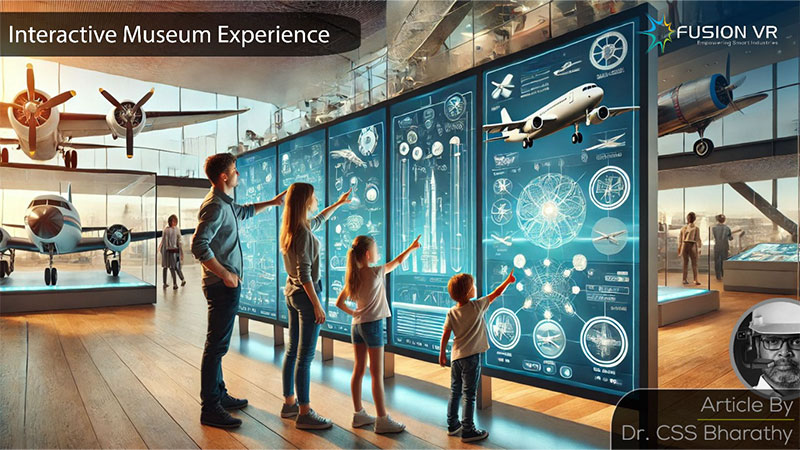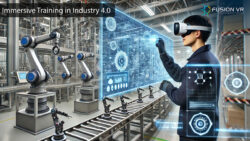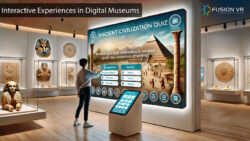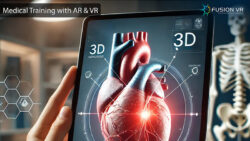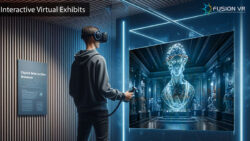When we think of interactive museums we think about places that are designed to engage and entertain visitors. Most museums till date are traditional museums where the displays are static and visitors just walk past them or read the information provided next to it, if any. The interactive museums engage visitors through hands-on activities with the museum’s exhibits and artifacts. Exhibits and experiences are created to actively engage visitors making it interactive, enjoyable and memorable for all visitors.
Some of the key features of interactive museums involve the use of Hands-on exhibits which have manipulatives and interactive displays. The manipulatives are essentially objects that visitors can touch, move or manipulate to allow greater exploration and consequently enable a better understanding. These also include interactive displays that respond to touch, motion, or voice commands from the visitor and deliver an experience according to their requests.
Most of the exhibits that enable an interactive experience are based on digital technologies such as touchscreens, augmented reality (AR), virtual reality (VR) etc. AR and VR are probably the most promising technologies in museums out there to enhance visitor interaction in a museum setting. Another key feature of interactive museums is they provide multisensory experiences through the use of audio guides, which deliver contextual content within an AR VR museum.
Another type of such multisensory experience is to create interactive soundscapes in museum exhibits that respond to visitors’ inputs. Some exhibits can also be designed to enable visitors to feel textures, temperatures etc. to understand and experience the nature of the exhibits. These experiences enhance learning, understanding of concepts and retention of educational content for visitors, particularly the young ones. Many modern libraries have interactive labs that house 3D printing devices for kids to experiment and learn through hands-on activities. In museums with an emphasis on history, interactive experiences could be built around storytelling, role playing and time travel AR VR museum experiences. Art museum exhibits also invite kids to participate in ongoing art projects that are interactive and encourage visitors to develop a better appreciation of art and artists. Such initiatives to make museums interactive help with collaborative learning and community engagement which reinforce the importance of museums as places of learning.
There are several renowned museums that are highly interactive such as the Exploratorium in San Francisco which is popular for its hands-on science exhibits. This museum provides the opportunity for all visitors to experiment with physical phenomena and learn through that experience. Other museums with similar initiatives are the Science Museum in London, The Museum of Science and Industry in Chicago, The City Museum in St. Louis etc. Closer to home we have the Amma Memorial Museum and the Kalaignar Memorial Museum in Chennai which feature many interactive exhibits.
When creating an interactive museum, we need to consider several factors to help it become a successful one. First and foremost is the uncompromising position of all stakeholders to remain committed to the user experience. The final product should be embraced by the community and it is their verdict that determines the effectiveness of an interactive museum experience. The team that is tasked with the development of an interactive museum should be a cross-functional team that also includes key decision makers as well. It is important that they understand the processes, constraints and success factors necessary to create an interactive museum experience.
The first factor is to clearly define the objectives and the target audience. The objectives should clearly articulate the engagement goals as well as the educational goals that the museum wishes to achieve. These goals should become the beacon for the project and ensuring adherence to the goals helps achieve the interactive museum objectives. Also, ensuring that the team understands the demographics of the target audience and their interests. The visitor group is the key stakeholder and understanding their needs is paramount. Another lesser known objective is ensuring the accessibility needs of the audience and enabling everyone to have an equally fulfilling experience. In most projects, the needs of the disabled and visually impaired may get ignored.
The second factor is the subject of concept development. The museum should seriously consider engaging the services of an experienced museum digital solutions consultant or service providers such as Fusion VR. A collaborative team of the museum staff, consultant, engineers etc. work together to develop a central theme for the museum and the various focus areas based on the objectives agreed earlier. The concept driving each of the themes and stories should be agreed by the team for further development. The narrative for each exhibit should make the overall visitor experience more cohesive and pleasant. The sequence and arrangement of exhibits should fit the overall museum narrative and make it easier for visitors to navigate through enjoyably.
The next most important factor is developing the overall scope of the exhibit. This includes the engineering, procurement, installation, testing and commissioning of the exhibit. The detailed requirements concerning the functional, aesthetic and technical aspects of the exhibit should be clearly captured in the scope document for the effective understanding and execution of the project by a chosen solutions provider or contractor. The technical aspects, including the safety and emergency requirements should be clearly defined to ensure the proper delivery of the visitor experience.
The experience of the solutions provider is another major factor is the development of interactive museum exhibits. Museum projects are unlike typical engineering projects as they require the creative, technical and academic skills of a truly cross functional team to deliver an interactive experience. It pays to visit and experience the projects of a potential museum solutions provider before making the final choice for your interactive museum exhibit.
Developing and curating the content requires the collaboration of various museum departments. They need to gather the most accurate and relevant information that is required for the exhibit. This is necessary to deliver an experience that is authentic and does not lead to unwanted controversy, particularly in exhibits that are historical in nature. The content may need to be reviewed and vetted by experienced professionals and academics in such cases. The content presented must also be clear and concise. The user experience is only for a few minutes and delivering the right amount of information is crucial.
As the above factors get adequate consideration, the most important one is the type of interactivity required for each exhibit. The kind of touchscreens, AR and VR components, the use of interactive displays, screens, audio design etc. need to be reviewed, chosen and integrated into the visitor experience design. Each interactive exhibit should enable the visitor to take away something from that experience. It could be souvenirs, selfies, badges, certificates or just a feeling of immense joy coming from that experience. The human factors concerning an interactive exhibit need careful consideration by the core team responsible for the interactive museum exhibit.
Some of the exhibits may be attempted for the first time and in such situations, the need for prototypes and proof of concept arises. These need to be tested and validated to ensure a smooth and seamless user experience for the visitors. The social media integration of each interactive museum exhibit should be factored into the design of each exhibit and the space assigned for it in the museum. This aspect may assist the outreach efforts of the museums and enable them to bring in more visitors to the museum.
Creating any interactive museum exhibit demands a thoughtful approach that aims to balance the various objectives and demographic needs of the community it serves. As one of the pioneers in the development of digital interactive museums and corporate experience centers in India, Fusion VR is uniquely positioned to support museum projects, AR VR experience centers across the country. I encourage the reader to explore Fusion VR’s dedicated Museum 2.0 webpage to learn more about it and the exciting projects we have executed.

